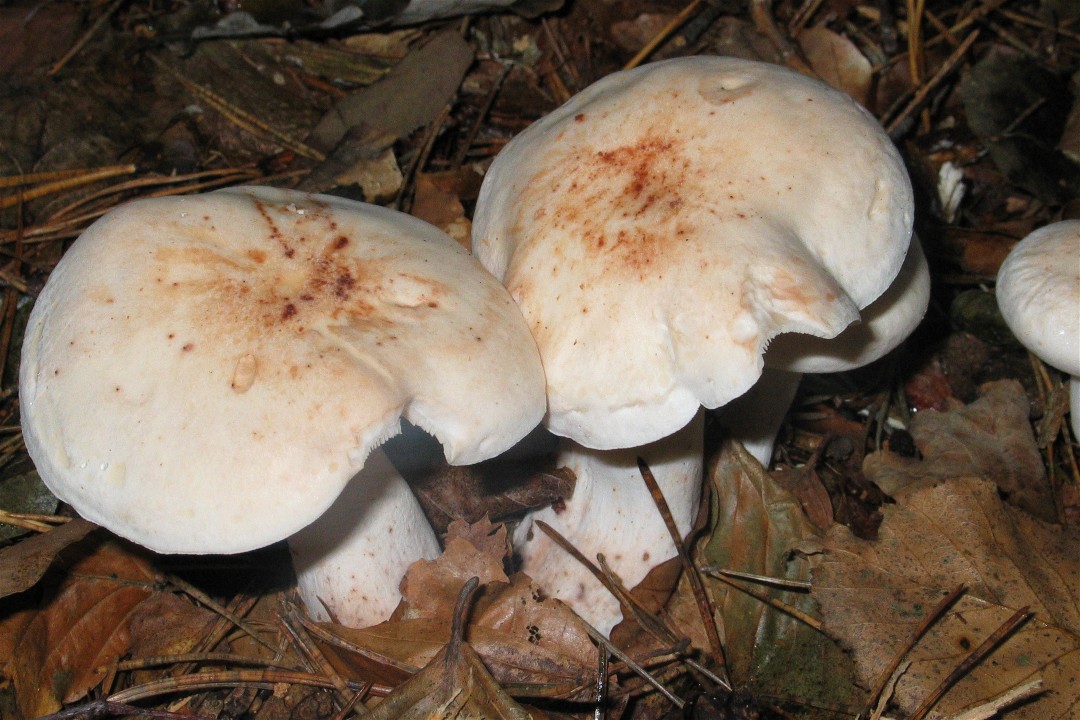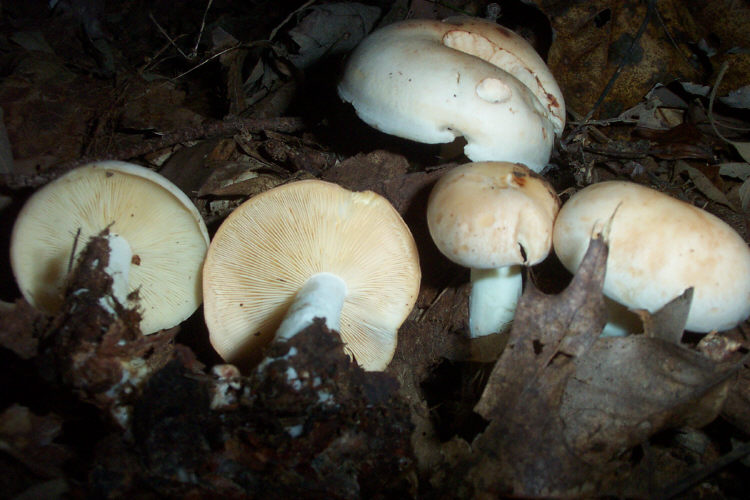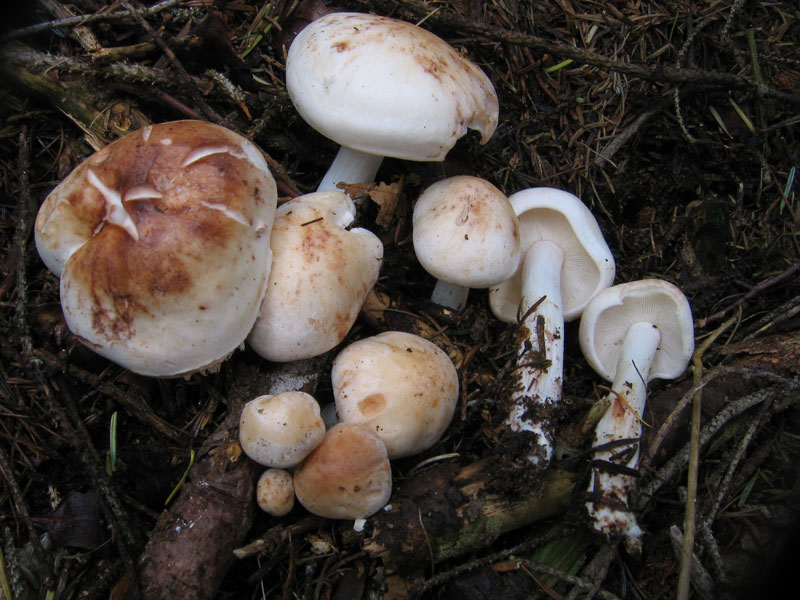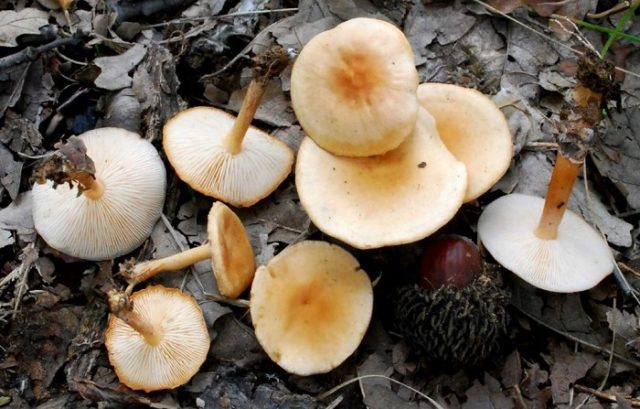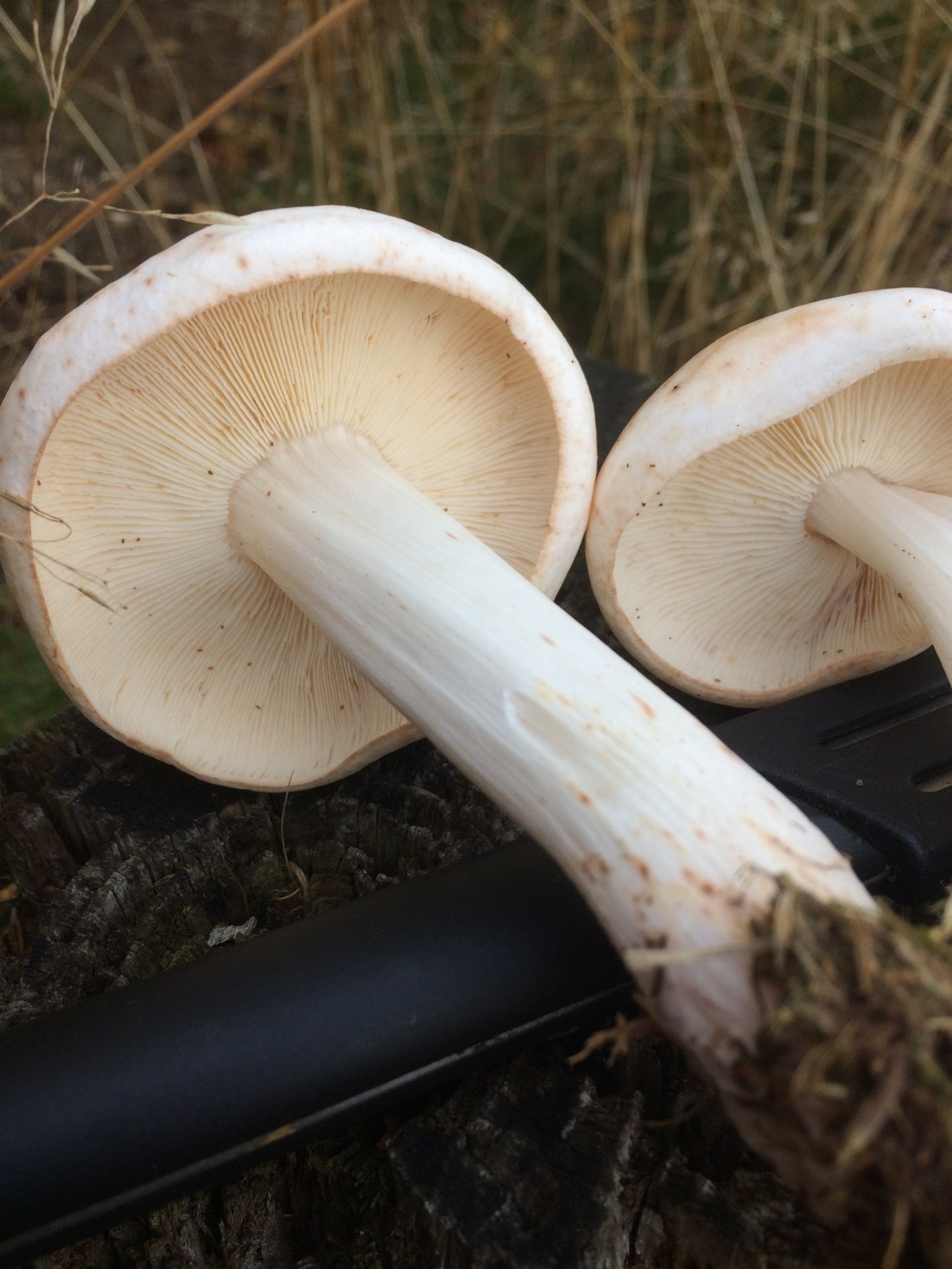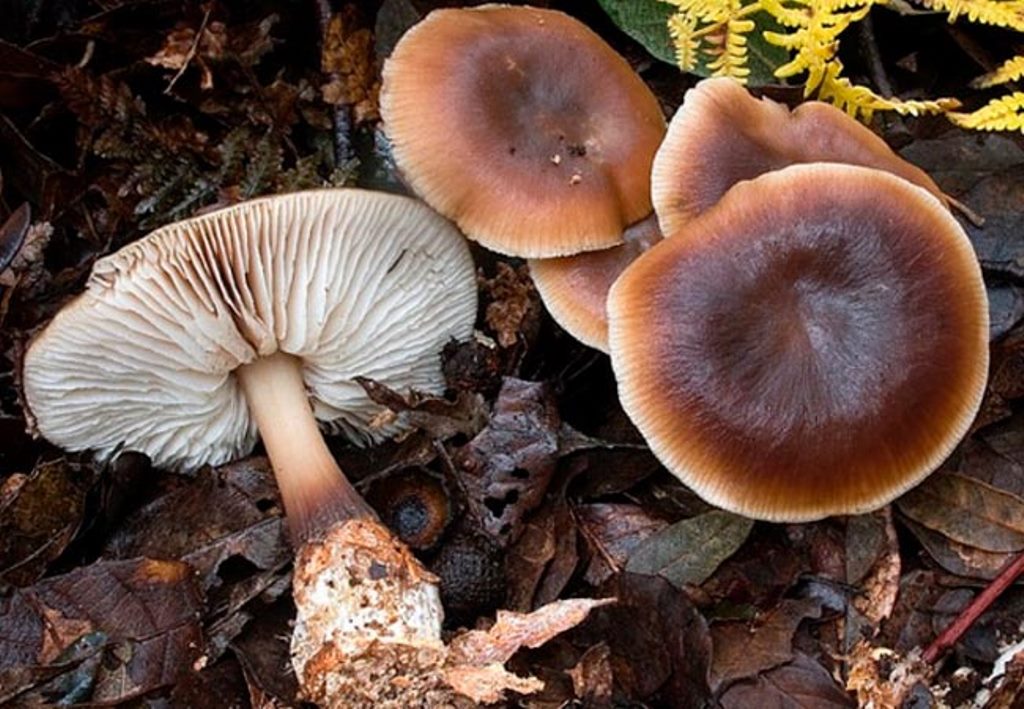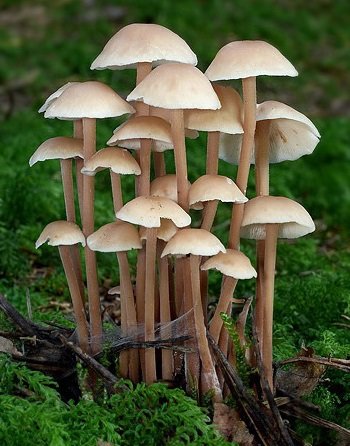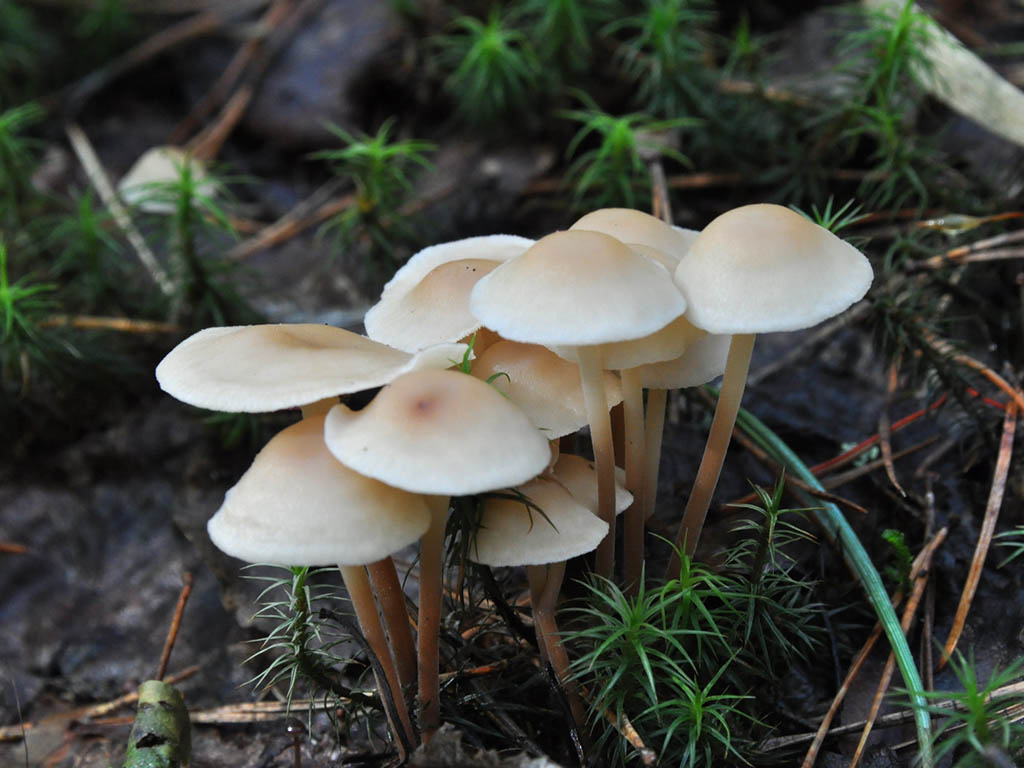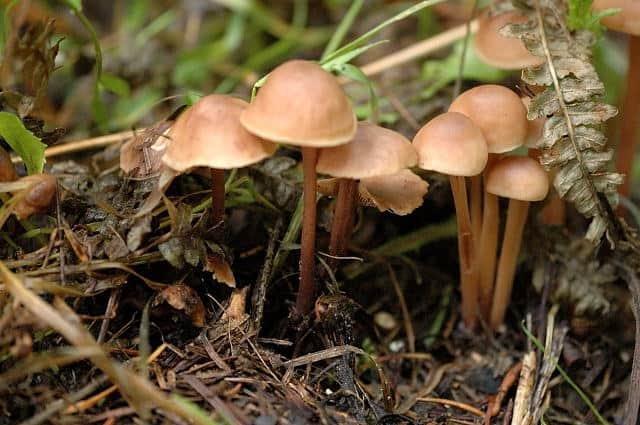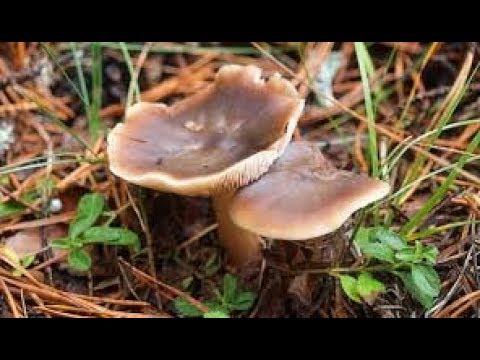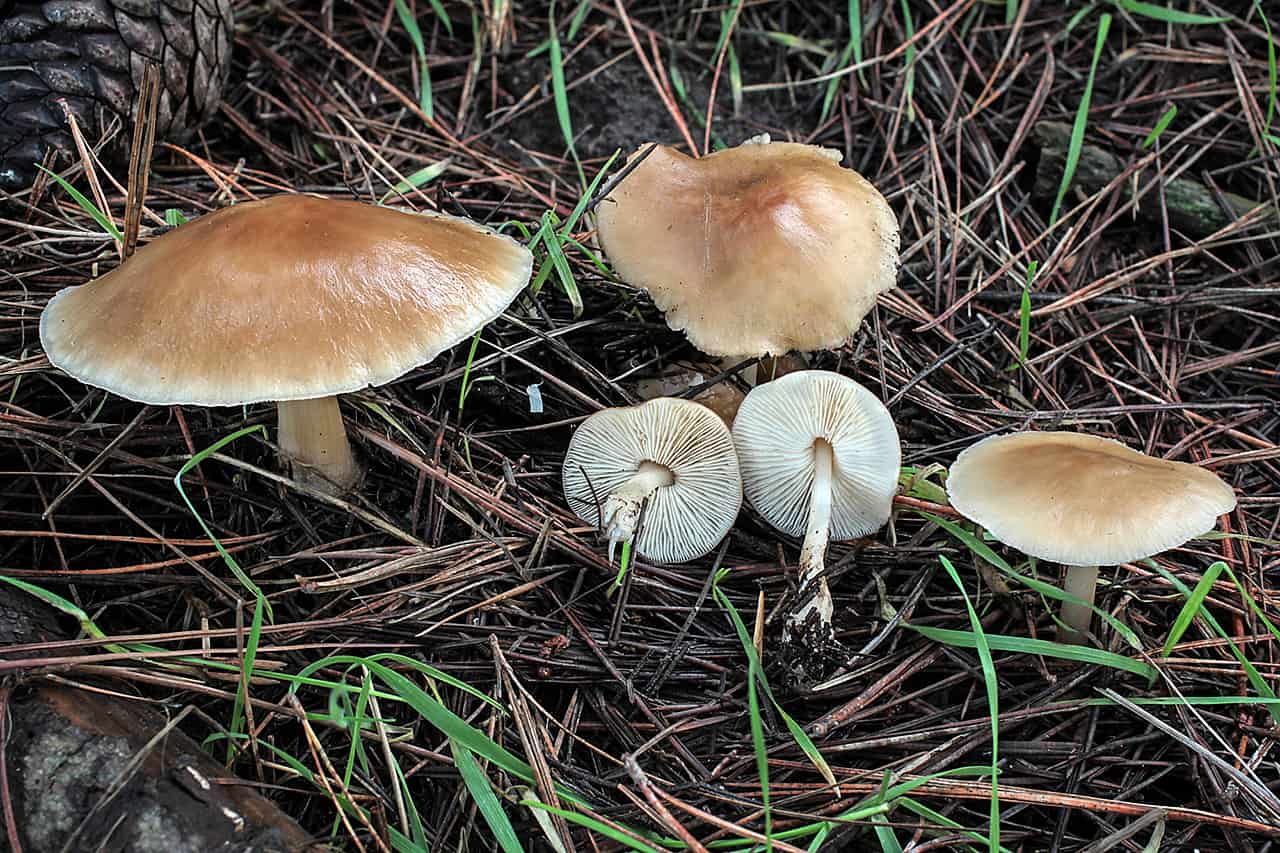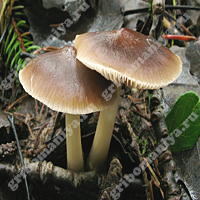Kollybia les-loving
Family: Ordinary (Tricholomataceae).
Synonyms: wood-loving money, oak-loving money, spring honey, forest meadow honey.
Description. The forest-loving colibia fungus is very diverse in color and size, and its color can vary from almost white to black-brown.
The range of the cap is inconsistent (it may be darker in the center and lighter at the edges and vice versa), brown-ocher, reddish, yellow-brownish, sometimes with a reddish tint, pale ocher. The transparent stripes along the edge of the cap are sometimes pronounced, sometimes not very much. When dry, the cap becomes discolored.
Frequent and thin blades can be white, yellowish, clayey. It takes several years to get used to the spring forest in order to learn to recognize it in all guises.
In part, the wood-loving money resembles a meadow honey fungus, differing from it primarily in a hollow leg with a brown or rusty tint inside. The hat is 3-8 cm in diameter, at first hemispherical or convex with a drooping edge, then convex-outstretched, prostrate, sometimes with a drooping or wavy edge, slightly depressed.
The flesh is thin, whitish, dense in the stem, with a weak mushroom odor. Stem 3-8 X 0.2-0.5 cm, smooth, hollow, more or less monochromatic with a cap, reddish or brownish at the base, pubescent.
It is found throughout the temperate zone of Russia in forests of various types. The forest-loving colibia fungus grows on litter and rotten wood, often covering dead wood and old stumps with a continuous carpet. Fruiting from late April to early November.
Similar species. It differs from meadow mushroom (Marasmius oreades) primarily in more frequent blades and the absence of a tubercle on the cap. Collibia chestnut (C. butyracea) is distinguished by more fleshy fruiting bodies, a clearly widened leg at the base and always a brown cap to one degree or another.
Medicinal properties: β-glucans, which have strong anti-inflammatory activity, have been isolated from the fruit bodies.
In addition, CDP induces a significant increase in prostaglandin E2 production in macrophages.
Culinary Uses: Lesser Colibia is a good edible mushroom of small size, used fresh and for drying.
Despite the mineral poverty of cucumbers, their useful properties are quite high. These fruits saturate cells with moisture, promote the elimination of fluid from the body and ...
Read completely "
As an auxiliary treatment for stomach and duodenal ulcers, folk remedies are often used: herbal preparations and phytoapplications. Also in therapeutic ...
Read completely "
Read more »Treatment of diseases, Phytotherapy
Raw raspberries are a storehouse of medicinal substances, so its use in the treatment of various diseases is quite justified. Folk remedies using raspberries are recommended ...
Read completely "
It turns out that the fruit stalks have no less useful properties than the berries themselves. For example, strawberry stalks are beneficial for gout, skin problems, and gastrointestinal disorders. And medicinal ...
Read completely "
Pumpkin seeds are not only a tasty "snack", but also a raw material for the manufacture of drugs for pharmacological and cosmetological action. Pumpkin seeds are used ...
Read completely "
Read completely "
The use of viburnum seeds in folk medicine and cosmetology is quite widespread. It is recommended to use viburnum seeds as a remedy for colitis, ...
Read completely "
Like grape seeds, apricot seeds have useful properties, therefore they are actively used in folk medicine and cosmetology. From the kernels of apricot kernels ...
Read completely "
Treatment with grape seeds has been practiced since ancient times: thanks to the presence of resveratrol and the flavonoids of proanthocyanides, grape seeds contribute to better assimilation ...
Read completely "
Varieties
Spindle-footed
Collibia fusiform grows on the stumps and roots of old deciduous trees, preferring oak and beech. A hat with a diameter of 4.0-8.0 cm, with a blunt tubercle. The pulp is tough. The spindle-shaped leg is 4-8 cm long, 0.5-1.5 cm thick. The color range is in red-brown shades.
Widely distributed in European forests. The fruiting period is in summer and autumn. It is considered inedible, but there are cases of the use of young specimens with exquisite gastronomic qualities. Overgrown specimens cause mild poisoning.
Oil
Colibia oil prefers coniferous forests, grows in colonies. The fruiting period is July-November.
A hat with a diameter of 2-12 cm, the surface is smooth, when moisture gets in, it becomes oily, which became the determining factor in the name of the species.
Irina Selyutina (Biologist):
The flesh of the cap of the oil colibia has an interesting feature - hygrophane, i.e. it is capable of swelling when exposed to moisture. This is due to the fact that the trama (false tissue) of such pulp is represented by a loose weave of hyphae. And it is in these gaps between them that the water coming from the environment is retained. Gigrofanny hats are capable of changing color depending on the weather. So, when dry, concentric zones appear on their surface, and their distribution can go from the center to the edge or vice versa.
The color is brown or with shades of red. Mushroom stem 2-10 cm long, 0.4-1.0 cm thick, often hollow, hard, smooth surface. It belongs to the edible species.
Lazy
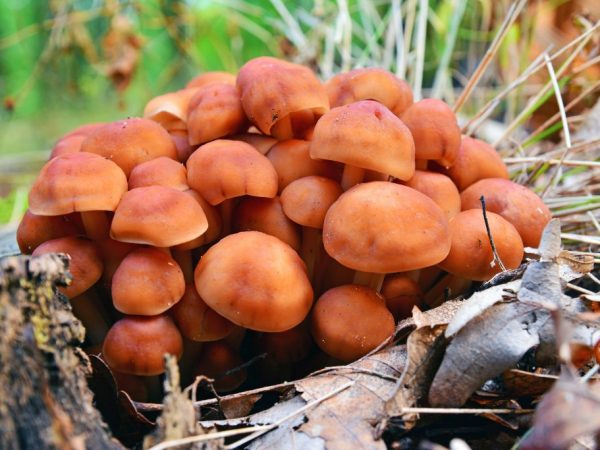
The fungus grows in colonies
Wood-loving colliery grows in small colonies in mixed woodlands along with oak and pine, preferring decaying wood and fallen leaves. The fruiting period is June-November.
The hat is 1-7 cm in diameter, the color is initially red-brown, later with an orange tint or yellow-brown. The flesh of the cap is thin, whitish, characterized by the presence of hygrophilousness. The mushroom leg is 3-9 cm long and 0.2-0.8 cm thick. Collebia wood-loving belongs to the edible species.
Bored
Crowded collibia is found near grassy paths, in clearings in coniferous forests, in hilly areas.
The cap is 1-4 cm in diameter, convex in young specimens, and straightened in adults. The surface is glossy. The hymenophore is pinkish. The leg is in the form of a cylinder, 5-10 cm high, up to 3 mm thick. The fruiting period is in spring-autumn.
The mushroom is an edible variety, but it does not have much culinary value due to its small size.
Wide-lamellar
Colibia broadly lamellar is one of the early lamellar fungi. Grows singly or in small colonies. It is a saprotroph, preferring the rotten stumps of broad-leaved trees.
A hat with a diameter of 5-12 cm, radially cracking in dry weather. A tubercle remains in the center of the cap. In adult mushrooms, the edges may bend upward. The surface is gray or brown. Mushroom stem 4-15 cm, cylindrical, widened at the base, dense in structure.
It belongs to the edible species.
Water-loving
Colibia water-loving, or hymnopus water-loving, grows in forests in wetlands with stagnant water, near the passage to the surface of groundwater, prefers moss, grass and soil rich in woody debris. The fruiting period is mid-May-November.
Mushroom cap with a diameter of up to 6 cm, initially with even, later with wavy edges. The surface is smooth. The color is usually cream, light brown. The leg is up to 8 cm long, 0.2-0.4 cm thick, in the form of a cylinder.
It belongs to the edible variety.
Collibia fusiform, Spindle
Hat.Diameter 3-10 cm, red-brown, convex at a young age, becomes flatter as it matures, with a blunt tubercle and an uneven surface, with dark spots. The plates are sparse, wavy, connected by membranes, free or slightly adherent. The color of the plates in young mushrooms is grayish, in mature ones it is reddish with rusty spots. The pulp is white, dense, cartilaginous. Smell and taste are practically absent.
Leg. Height 8-12 cm, fusiform, characteristic of this fungus, very rigid, covered with grooved grooves, ending in a deep tapered appendage. In maturity, it becomes hollow, often flattened.
Spore powder. Whitish cream.
Habitat. At the foot of deciduous trees and at stumps, often in bunches, less often singly.
Season. Occurs in summer, but the main fruiting in autumn.
Similarity. Can be confused with autumn and winter honey. But the characteristic stem and plates usually do not allow it to be mistaken for another mushroom.
Use. Due to its tough pulp and inexpressive taste, the mushroom is not popular. According to some sources, it is weakly poisonous, according to others, it is inedible.
How to cook wood-loving Colibia
Before preparing dishes from wood-loving colibia, it is boiled for at least 30 minutes. At the first boil, the water is drained, a new one is added and the cooking continues.
After heat treatment, honey mushrooms can be stewed or fried, eaten with cereals or vegetable and meat dishes, as well as separately. You can freeze, dry or salt the wood-loving colibia. It is added to the soup 20 minutes before it is fully cooked.
Salting of Kollibia wood-loving
To salt 1 kg of young spring colibia, you will need:
- salt - 50 g;
- dill - 50 g;
- allspice - 12 peas;
- onion - 1 pc;
- bay leaf - 2-3 pcs.
- The hats are cooled after heat treatment.
- In a container for salting, you must put bay leaves, chopped dill and onions, allspice.
- On top (with a layer of 5 cm), lay the caps of the wood-loving colibia, evenly sprinkling them with salt. If you get another layer, it is also covered with salt and pepper on top.
- Cover the container with a cloth, set the load on top, closing it with a hermetically sealed lid.
- Leave in a dark place for 40-45 days.
If after a few days foam is found, it must be removed, the product is decomposed into clean and sterile jars, placed in a cool place, waiting for complete salting. You can add the finished product to salads, snacks, pies, soups and other dishes.
How to freeze spring honey
You need to freeze after heat treatment. The wood-loving colibia should be cooled, dried and folded into a clean bag, sprinkled with fresh chopped herbs. In the freezer, the dish is stored for no longer than six months.
Recipe for wood-loving colibia (frozen) with sour cream and herbs:
- sour cream - 0.5 kg;
- mushrooms - 1.5 kg;
- onions - 2 pcs.;
- a bunch of dill;
- butter - 50 g;
- ground pepper - to taste;
- salt to taste.
- Defrost the mushrooms in a skillet until the liquid has completely evaporated.
- Finely chop the onion, fry in another pan until softened.
- Combine onion with mushrooms, add butter, salt and pepper.
- Pour in sour cream, wait for the dish to boil and add dill.
- After 2 minutes, remove the dish from the heat. It is ready to eat.
How to fry wood-loving Colibia
Fry wood-loving colibia after boiling with vegetables or on your own. If you use a recipe with vegetables, then the mushrooms are added last. The dish takes about 20 minutes to cook.
(collision)
✎ Affiliation and generic features
Money or colibia (lat.Collybia) is a genus of mushrooms of the family of ordinary (lat.Tricholomataceae), bright order agaric (lamellar) (lat.Agaricales).
The name of the genus Collybia develops from the ancient Greek word: κόλλῠβος, literally translated into Russian, means "broken penny" or "polushka".
There are about 70 species in the genus of money, and all of them (without exception) are saprotrophs that grow in forests, on the rotten fruiting bodies of other mushrooms, 20 of which are recorded in Russia.
Of course, it is difficult to attribute them to edible mushrooms, because of the taste of sawdust, but some of them are all edible, and may be of certain interest to mushroom pickers already as conditionally edible mushrooms, and this:
- ordinary money (wood-loving);
- chestnut coin (oil);
- spotted money;
- wide-plate money;
- curved money (twisted),
the first of which (ordinary money (wood-loving) is called everywhere "spring honey", the rest are considered inedible, and this:
-
spindle-footed money
; -
tuberous money (tuberous)
; -
wrapped money (shod)
; -
money merging (merging)
,
other.
Only poisonous representatives in the genus have not been identified in money.
✎ Similar species and nutritional value
Money is quite similar to each other, and it will not be difficult to confuse them. They have inedible or slightly poisonous counterparts, for example:
-
- slightly poisonous sulfur-yellow pseudo-foam;
- slightly poisonous pseudo-foil, brick-red,
which are completely unfit for human consumption, or:
- - slightly edible
pseudofoam seroplate
,
which, if eaten, is extremely rare and after boiling.
In terms of consumer and taste qualities, every edible money mushroom is valued as conditionally edible mushrooms of the fourth category and is always used only after preliminary boiling (within a quarter or half an hour). Otherwise, you can experience the unpleasant sensation of eaten sawdust and even get a little upset stomach.
✎ Distribution in nature and seasonality
Money is decently common in the temperate zone of the Northern Hemisphere, found in Eurasia and North America, but quite rarely.
Colibies are normally common in the forests of Europe and central Russia - in the Urals, in Siberia, or in the Far East (in the Primorsky Territory, for example).
Money grows, mainly in humid, coniferous and deciduous forests, on forest litter, land with coniferous litter, on old stumps and dead wood, on trees (already dead or dying, whether they are coniferous or deciduous), foldably in large groups.
Intense ripening for some money begins at the very beginning of May (for which they are called "spring mushrooms"), continuing through December, easily tolerating frosts.
✎ Brief description and application
Money is referred to the section of lamellar mushrooms, and the spores for their reproduction are packaged in plates. Their fruit bodies are dwarf and are painted in pale colors (whitish, brownish, gray and light yellow). The plates are frequent, adherent to the stem, light or brown, white in young fruits, rusty in adults. The caps do not exceed the standard size of the coin in diameter, they are often convex or flat, rarely (with age) with a dimple in the center; in youth they are flat-convex and with curled edges, brown-brown in color, but in maturity they are prostrate and watery, yellowish, reddish or slightly brown in color. Legs are thin, cartilaginous, with a mealy coating, sometimes hairy in the lower part, and the characteristic "chaffin" rim is absent on them. The flesh is thin, but fleshy, white in color.
Money is used in boiled, fried, dried, salted, pickled form (though only hats, because their legs are tough and have no nutritional value).
However, there is nothing special and there is nothing, and the taste is completely absent (this is far from a honey mushroom, one name). On the other hand, trying is not forbidden.
general characteristics
All members of the Collibia genus have similar characteristics:
- Hat: thin-fleshy, in rare cases has a well-developed flesh, small in size, does not exceed 2 cm in diameter, convex in shape at the initial stage of growth, subsequently flat-spread, in adult specimens a fossa appears in the central part, in young mushrooms it has rolled edges, pale in shades of white, brown and yellow.
- Hymenophore: formed by frequent plates adhered to the bases of the mushroom stem or free, the color of the hymenophore plates can be pale cream or light brown.
- Leg: thin, covered with a mealy bloom, the lower part of the leg is usually hairy, the shape of the leg is often even, cylindrical, in some cases swollen.
Some types of colibia form sclerotia.
Spring honey mushroom (les-loving colibia), description of where it grows
Spring honey. Collybia oak-loving Collybia dryophila (Latin name). Belongs to the family Marasmiaceae. In former times, it belonged to the genus Collybia of the Tricholomataceae family. The genus includes about 70 species. People call this mushroom money. This mushroom is also called: forest-loving colibia. The mushroom is conditionally edible.
Where grow
Like other types of honey fungus, oak-loving kollibia prefers stumps. Usually, these mushrooms are collected in impassable places with spruces, aspens and old birches, in dry conditions. Columns of mushrooms are large in size.
Usually, the spring honeydew is collected by those mushroom pickers who can distinguish it from its counterparts. The spring honeydew chooses deciduous and coniferous forests. This mushroom can be found in central Russia, in European forests, in the Far East and Siberia, in the Urals.
The mushroom ripens in early May and is harvested until October.
Description
The cap of this mushroom is small in size - 2-6 cm in diameter. The hat is smooth to the touch. The color is red or yellow-brown. First, young mushrooms have a convex cap shape, which becomes prostrate over time.
The plates are pale, faded, white and yellow. Frequent and adherent to the peduncle. Spore powder is white.
The stem of the mushroom is smooth, reddish brown. Light felt, stiff and fibrous near the base.
The pulp is pale in color, tender.
Beneficial featuresThe mushroom is not of high quality, but it is edible. Colibia oak-loving belongs to the 4th category.
You can fry, marinate in a mixture with other mushrooms. There are a large number of active elements in the mushrooms.
If you often eat these mushrooms, it will increase the body's resistance to infections, improve the functioning of the cardiovascular system. Also, these mushrooms have a positive effect on the gastrointestinal tract.
They have antioxidant, antiviral, immunostimulating, anti-inflammatory effects on humans.
CompositionIn mushrooms there is a lot of fiber, proteins, carbohydrates. A large amount of vitamins (C and B1), copper and zinc, mineral elements.
If a mushroom picker caught an inedible mushroom, then it is possible to distinguish it from an edible one, focusing on the unpleasant smell of sour, spoiled cabbage and on the pubescent leg of the twins.
Recipes
Certain types of honey mushrooms need to be cooked for a long time, as they are toxic. Usually honey mushrooms are cooked from half an hour to an hour, depending on their size. When the mushrooms boil, the water is drained and boiled in another water. It is better to boil it even earlier. Before eating this mushroom, you need to heat the product.
It usually takes half an hour to cook. Spring honey will go well with cereals, vegetables, pork, lamb, beef, poultry.
They are fried and stewed. Can be used alone or with other products. Young mushroom caps are best for pickling and pickling.
Vinegar works well as a flavor enhancer and as a preservative.
- Honey mushrooms with herbs and sour creamYou should take 500 grams of sour cream, 500 grams of honey mushrooms, 2 red onions, 1 bunch of dill, 50 grams of butter, black pepper and salt to taste. Frozen mushrooms are placed in a frying pan without defrosting. Fry until moisture evaporates. Peel and cut the onion and fry until soft in a hot skillet. Combine onions and mushrooms, add butter, heat, and then add pepper and salt. Place sour cream in a dish, let it boil, add dill. Remove from heat after a minute, mix all the ingredients and you can eat.
- Salting honey agaric
For salting, you need 500 gr. salt, ten kilograms of honey agarics, dill, 120 allspice peas, chopped onions, bay pepper. You can take mushrooms of different sizes. Rinse thoroughly, completely cut off the legs from large specimens. Cut the hats into pieces, place the pot with water on the stove, put 1 teaspoon of salt in 1 liter of water. Place the mushrooms inside after boiling water.
Cook for 20-25 minutes, then place in a colander until it cools down.In a bowl for salting, put bay leaf on the bottom, dill, chopped onion, pepper, and then a layer of honey agarics 5 cm thick. . mushrooms). After that, a layer of mushrooms and spices should be placed in the salting dish.
The mushrooms are covered with a cloth, and a lid and load must be placed on top.
Bring to readiness within 35-45 days in a dark place.
The article is here
Collibia spotted
Collybia maculata - Latin Collybia maculata
In another way, the mushroom is called Spotted Money or Spotted Gymnopus.
Description
Mushroom cap
The spotted money has a rather large cap, reaching 50-120 mm in diameter. The hat of the young specimen resembles the shape of a bell, cone or hemisphere with uneven outlines. In the future, it straightens out and becomes almost flat, with bent edges. Occasionally, the mushroom takes on bizarre shapes, becoming like the palm or paw of an animal: it rarely has a proportional appearance.
"Headdresses" are covered with a smooth dry skin of white or cream color, mottled with merging and separate small and large specks of a reddish hue, making this mushroom different from other brethren. The skin is not highly absorbent and does not change color even in prolonged rainy weather.
The inside of the hats contains a white fleshy flesh that is highly dense and elastic. Its color does not change after contact with air when cut or broken off.
The hat bottom is formed by very frequent thin white plates that adhere tightly to the legs.
Collibia spotted reproduces as smooth, colorless, round or oval spores that mature in a creamy pink spore powder.
Stipe
The spotted hymnopus has a matte smooth cylindrical or fusiform stem 5-12 mm thick and 60-120 mm high. It usually narrows towards the base (but it can also expand) and goes to a considerable depth into the ground, it can swell in the middle.
Legs are somewhat twisted and curved, with dense fibrous pulp. In adulthood, they become hollow. The color of the legs is unusual: on a white background, brownish (reddish) spots and stains.
Growing places
Spotted money prefers damp pine forests and mixed forests of the European regions of Russia and Primorye
It is important for her that the soil is moist and sour. The fungus is found on bryozoans, on the soil under trees, rotting stumps, twigs and other wood remains
Spotted hymnopus, depending on the climatic characteristics of the region, does not bear fruit for long - from late July to mid-September or in August-September. Fruiting of the mushroom, which is highly decorative, occurs in numerous families.
Edibility
The pulp of these colibies exudes a subtle mushroom aroma or does not smell at all. It is extremely tough and too bitter to be consumed for culinary purposes.
Although the mushroom is non-toxic, it is classified as an inedible category precisely because of its excessive bitterness. Even if you boil the spotted money several times or salt it with various seasonings, the bitter taste will not go anywhere.
Collibia mushroom: wood-loving, oily and others

The colibium fungus belongs to the Tricholomaceae family. It has several varieties, among which the most famous are the forest-loving, broad-lamellar, oily and fusiform.
Description of the Collibia mushroom and its varieties
general characteristics
All members of the Collibia genus have similar characteristics:
- The mushroom cap is thin-fleshy, in rare cases has developed flesh, small in size, does not exceed 2 cm in diameter, convex in shape at the initial stage of growth, subsequently flat-spread, in adult specimens a fossa appears in the central part, in young mushrooms it has tucked edges, color pale in shades of white, brown and yellow,
- the mushroom hymenophore is formed by frequent plates adhered to the bases of the mushroom stem or free, the color of the hymenophore plates is pale cream or light brown,
- the mushroom leg is thin in shape, covered with a powdery coating, the lower part of the leg is hairy, the shape of the leg is often even, in some cases swollen.
Some types of colibia form sclerotia.
Geography of distribution
The genus collibius is widespread in temperate latitudes in the European and North American territories. In total, there are about 70 varieties, in Russia there are about 20 species.
Colibia are sapostrophs; they grow in coniferous and deciduous forests on rotten fruit bodies of other types of mushrooms, on forest litter and dried wood, preferring grass and mosses. In rare cases, they settle on living trees.
Spindle-footed
Collibia fusiform grows on the stumps and roots of old deciduous trees, preferring oak and beech. A hat with a diameter of 4.0-8.0 cm, with a blunt tubercle. The spindle-shaped leg is 4-8cm long, 0.5-1.5cm thick. The color scheme is in red-brown shades.
Widely distributed in European forests. The fruiting period is in summer and autumn. It is considered inedible, but there are cases of the use of young specimens with exquisite gastronomic qualities. Overgrown specimens cause mild poisoning.
Oil
Colibia oil prefers coniferous forests, grows in colonies. The fruiting period is July-November.
A hat with a diameter of 2-12 cm, the surface is smooth, when moisture gets into it, it becomes oily. The color is brown or with shades of red. Mushroom leg 2-10 cm long, 0.4-1.0 cm thick, often hollow, hard, smooth surface. It belongs to the edible species.
Lazy
The fungus grows in colonies
Wood-loving colliery grows in small colonies in mixed woodlands along with oak and pine, preferring decaying wood and fallen leaves. The fruiting period is June-November.
A hat with a diameter of 1-7 cm, the color is initially red-brown, later with an orange tint or yellow-brown. The mushroom leg is 3-9cm long and 0.2-0.8cm thick. Collebia wood-loving belongs to the edible species.
Bored
The crowded variety grows near grassy paths, in clearings in coniferous forests, in hilly areas.
The hat is 1-4cm in diameter. the surface is shiny. The leg is in the form of a cylinder, 5-10cm high, up to 3mm thick. the fruiting period is in spring-autumn.
The mushroom is an edible species.
Wide-lamellar
Colibia broadly lamellar is one of the early lamellar fungi. Grows singly or in small colonies. It is a saprotroph, preferring the rotten stumps of broad-leaved trees.
A hat with a diameter of 5-12 cm, radially cracking in dry weather. The surface is gray or brown. Mushroom leg 4-15cm, dense in structure.
It belongs to the edible species.
Water-loving
Collibia water-loving grows in forests in wetlands with stagnant water, near the passage of groundwater, prefers moss, grass and soil rich in woody debris. The fruiting period is mid-May-November.
Mushroom cap with a diameter of up to 6 cm, initially with smooth, later with wavy edges. The surface is smooth. The color is usually cream, light brown. Leg up to 8cm long, 0.2-0.4cm thick, cylinder shape.
It belongs to the edible variety.
Conclusion
Collibia belongs to the genus of basidial lamellar fungi from the family of rowers. It has several varieties, most of which are edible or conditionally edible.



